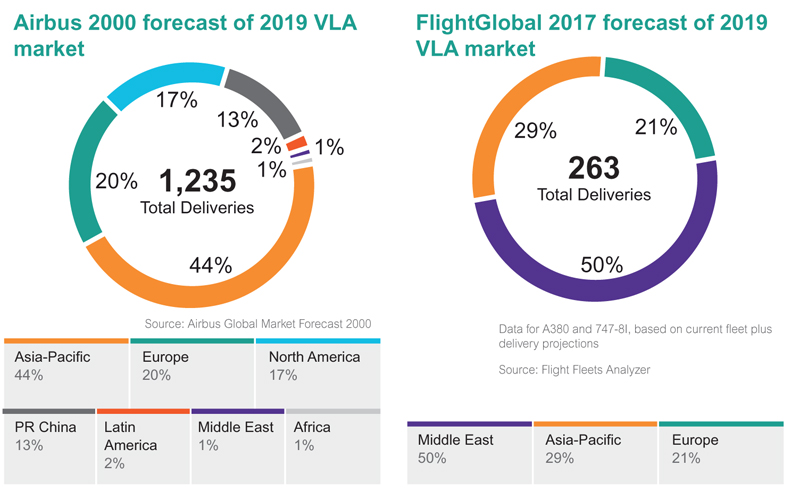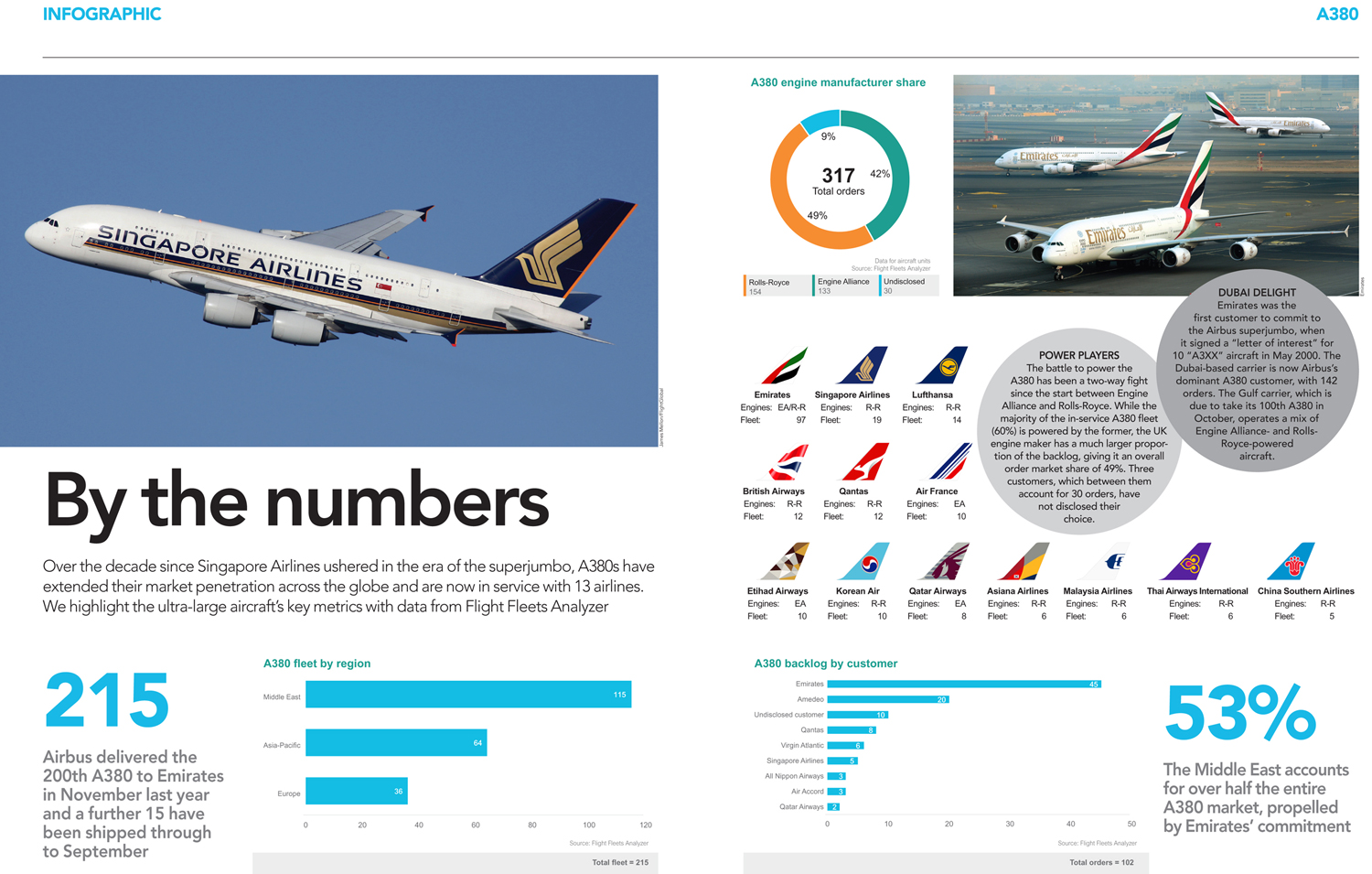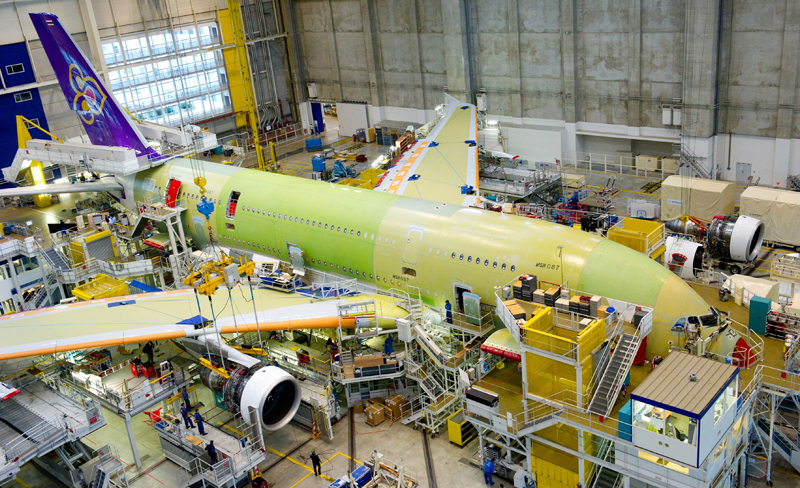Since the Airbus A380 made its world debut with Singapore Airlines a decade ago, the double-decker has gone on to establish itself as the flagship of the fleet at every one of its 13 operators. Airbus has delivered some 215 aircraft and is rightly proud of the game-changing passenger experience that the A380 has brought to air travel.
But unfortunately the A380 story doesn't end there. Airbus has spent the past 10 years trying to convert the big jet's size, unrivalled passenger experience and operating-cost benefits into a solid sales story with little of the success it feels it deserves.
The A380 was launched with the intention of overhauling and supplanting the Boeing 747 as the industry’s queen of the skies, but after a strong start sales have dwindled and production rates are being slashed. Hence, 20th-century assumptions about the unparalleled benefits of the A380's size and economics have been called into question amid the changing market dynamics of the 21st century.
IAG chief executive Willie Walsh summed up the A380's situation in an interview with FlightGlobal last year, when he revealed that the airline could be interested in adding a few incremental units. "Customers love it. The aircraft works very well," said Walsh, but he cautioned that the second-hand market was the most likely source as the price of a new A380 was "outrageous".
While Emirates was the first to sign for the A380 (and has now ordered 142), it was SIA that took delivery of the first aircraft, with 9V-SKA arriving on 12 October 2007. SIA flew the inaugural A380 service 12 days later to Sydney. Unfortunately for Airbus, the 10-year milestone is coinciding with that first A380 being retired by SIA and returned to its lessor. While the airline has five more A380s on order, it has chosen to roll over its older aircraft rather than expand its fleet.
Since launching the A380 in December 2000, Airbus has accumulated a total of 317 orders from 18 customers. However, it has lost more than a few orders along the way, including the entire 27-strong orderbook for the A380 Freighter when Airbus was forced to terminate that programme in 2007.
But 10 years in, the A380 has achieved one of its objectives: the in-service fleet is just overtaking that of the 747 passenger variants as the number of the original Jumbo Jet in operation declines towards 200 aircraft.
"Airbus has indeed succeeded in removing the 747 as a competing passenger aircraft," says Richard Evans, senior consultant at Flight Ascend Consultancy. "However, the future market-share battle seems to have shifted to large single-aisles and 300-seat twin-aisles."
Flight Fleets Analyzer shows that the 747 passenger fleet has steadily declined from about 740 aircraft in 2000 when the A380 was launched. As the A380 arrived in service in 2007, the 747 passenger fleet had dropped to about 550 units and has gradually declined further as the Airbus superjumbo fleet expanded. Today, the combined fleet of A380s and 747s in passenger operation is about 430 aircraft.
The 747's decline and the A380's poor sales are no surprise to Boeing, which has consistently been pessimistic about the size of the market for very large aircraft (VLA).
While Boeing competes in the sector with the 747-8, the US manufacturer forecasts that "just a handful [of passenger VLA deliveries] going forward", says vice-president marketing Randy Tinseth. Boeing this year eliminated the VLA category from its long-term forecast.
"We see a large airplane market that is so small that we do not believe Airbus will deliver the rest of the A380's backlog," Tinseth says.
The scale of the market at which the A380 was aimed back in 2000 is evidenced by data from that year's Airbus Global Market Forecast (GMF). For the VLA category seating 400 passengers or more, the manufacturer estimated demand for 360 deliveries up to 2009 and a further 875 by 2019, putting total demand at 1,235 units (excluding freighters).
In that 2000 forecast, Airbus said: "The GMF confirms that if the airlines are to continue profitably to meet growing demand for low-cost air travel in the face of intensifying global competition and increasing congestion, they will need substantial numbers of a new generation of aircraft like the A3XX, larger and more economical than anything flying today."
There need to be some caveats around Airbus's legendary and consistently bullish outlook for long-term ULA demand – it puts 20-year deliveries at 1,400 passenger and freighter aircraft in its latest GMF. Airbus never claimed it would deliver 1,300-plus A380s in 20 years – this was its view of total demand, of which Airbus aimed to secure its usual 50% share – and competition from across the Atlantic was assumed.
Using that 50% proportion puts its 20-year demand forecast in 2000 in the 600-700 unit range – a figure that most of the A380's supplier stakeholders also assumed when evaluating whether to participate in the programme.

In the 10 years since A380 deliveries began, Airbus has delivered 215 aircraft. Although production reached about three a month at its peak, it has never achieved the expected four-a-month rate (with potentially up to eight a month once envisaged) and is now declining to around 0.5 a month.
To put those 215 deliveries in context, assuming the expected four-a-month rate had been achieved (after a three- to four-year ramp-up) Airbus could potentially have delivered 350-400 units over the first decade.
Production delays did not help the A380's early market penetration – deliveries began more than a year late amid build issues that slowed the initial ramp-up. But when it arrived, airlines and their passengers loved the A380.
"Despite a teeth-pulling two years through all the delays et cetera, this aeroplane is a peach," Emirates Airline president Tim Clark told FlightGlobal in our 2009 A380 in-service report Judging a giant.
"Once you've flown on it you will not want to go [any other way] if you have a choice – which will make them feel very ill in Seattle."
All the operators we spoke to back in 2009 put the A380's passenger appeal down to a combination of the quiet and spacious cabins, high standard of in-flight entertainment and its comfortable ride. "She goes through turbulence like a huge Queen Mary 2 on the North Atlantic in January," quipped Clark.
The A380 is popular with Asia-Pacific carriers, but not the the extent that Airbus forecast
Airbus
But its size and game-changing passenger experience has not been enough to enable the A380 to find the mass appeal that Airbus yearned for when it looked enviously at Boeing's success with the 747 back in the 1990s.
"I believe Airbus and Europe in general desperately wanted an aircraft that would have global prestige and also allow Airbus to offer a product that could compete with the – at the time – very profitable Boeing 747," says DVB Bank managing director and aviation research chief Bert van Leeuwen. "The 747 profits were supposed to allow Boeing to cross-subsidise its smaller aircraft. So the market projections at the time may already have been a bit over-optimistic."
Evans points out that the market the A3XX/A380 was devised for and the one where it finds itself competing have proved very different. "Competition has increased across the board, as markets have liberalised. When the A380 was launched, almost all Europe-Asia and transpacific routes were flown with 747-400s, generally at a fairly low frequency," he says.
"Since then, the number of routes has proliferated, with many markets becoming 'open skies'. So, instead of the A380 being the natural replacement for those 747s, most airlines have downsized to be able to offer higher frequencies and more routes."
Evans also points to the A380's operating economics as an issue when measured against machinery that was not around during its design stage 20 years ago.

"The A380 was targeted to enter service in 2004, and used technology available in that timeframe. Airbus designed the baseline aircraft to be stretched, but that never happened," he says. "The result is an aircraft with a very large wing and tail surfaces, and a high empty-weight-to-seat figure. Newer widebodies have eroded its cost-per-seat advantage, and the A350-1000 and 777-9X will match it."
Richard Aboulafia, vice-president of analysis at Teal Group, has long been an outspoken critic of the A380, describing it as "born to die". He predicts that the final delivery will take place by 2020, "with unpleasant losses all around".
"Launched with a hideous mix of hubris, shoddy market analysis, nationalism and simple wishful thinking, the A380 was destined for a short, painful life," he says.
"This has been a learning experience, albeit one for people who should have known better from the start. When launching a new jet, it's important to survey market trends, regulatory changes, likely technological developments, and customer preferences. None of that was done here."
Van Leeuwen believes that for many operators, the A380's unique selling point – its size – means it is simply too big. "While filling the aircraft is not that much of a problem, filling the plane with passengers that are paying a decent ticket-price seems to be more of an issue. The huge capacity supply offered by each A380 flight tends to erode away the yield."
Airbus's 2000 market forecast was also wide of the mark in terms of the regional breakdown in VLA demand. North America was viewed as a key target market when the A380 was launched, while the Middle East was just emerging on the global scene, from a network-carrier perspective – with little prospect of having much appetite for a 500-seater.
Flight Fleets Analyzer shows that at that time there were about 100 747s in passenger service with North American airlines, including 50 with United Airlines and 34 with Northwest Airlines (which merged into Delta Air Lines in 2009). So it was hard to quibble with Airbus's view at the time that North America would account for 17% of 20-year VLA deliveries.
But that market, of course, has proved barren for A380 salesmen as the US 747 passenger fleet has dwindled and none are left in Canada. Just 26 747s remain in passenger service now, and this will decline by a further 11 in November when Delta and United retire their remaining -400s.
Flight Ascend Consultancy head Rob Morris sees the impact of the 9/11 terrorist attacks as having fundamentally changed the dynamics of the US airline market, to the detriment of the A380.
"The A380 was expected to be an aircraft that would work for Northwest/Delta and United as 747 replacements on their transpacific routes where timezones restrict potential frequency and payload-range was key for many routes. But after 9/11, consolidation drove network changes, while the US majors also moved to constrain capacity and manage yield/profit. Today they are extremely successful at this."
Evans says the US airlines' focus on profit rather than market share has put their emphasis on business traffic and the need for daily frequencies. "The 747-400 was the right transpacific aircraft but by 2007 it was already being marginalised on the Atlantic," he says. "Asian carriers have gained market share from US airlines across the Pacific, but US airlines have higher yields and appear happy to use midsize widebodies like the 787."
Aboulafia believes the North American market failed to materialise because airlines had learned through bitter experience how devastating excess capacity could be.
"They also correctly realised that the future belonged to more city-pairs, which called for smaller long-range equipment like the 787 or A350 XWB," he says.
Flight Fleets Analyzer projects that by 2019, the Middle East (thanks mainly to Emirates) will represent 50% of the 263 ultra-large passenger aircraft deliveries (A380s and 747-8Is) while Europe will account for 21% and Asia-Pacific 29%. This compares, respectively, with 1%, 20% and 44% in Airbus's 2000 GMF projection for the 2019 VLA passenger fleet (1,235 aircraft).
"I don't think any of us saw the growth of the Middle East mega-connectors," says Morris, who believes that region's A380 appetite has probably displaced potential orders from elsewhere. "Although these have each been A380 customers, they have built their networks with traffic won from network carriers at either end of their flows, as well as stimulating some other traffic, of course."
Aboulafia says: "It's an interesting question why the European carriers in Airbus's 'home' countries have taken just 30-something A380s, and don't want any more. They, like the US airlines, have realised what needs to be done to compete in the international air travel market today."
Evans says the success of the Middle East hub carriers has created a power shift that has affected the likes of Singapore Airlines, Malaysia Airlines and Thai Airways, and probably prevented them placing follow-on A380 orders.
"Qantas is another obvious example, having pulled much capacity out of Europe that was flown by 747s. However, if Emirates had not been seen as the market leader, it is very doubtful that Qatar Airways and Etihad would have ordered the A380."

Production never quite reached the expected four per month - let alone a theoretical eight - and its now heading down, towards only 0.5
Airbus
Van Leeuwen points to the changing dynamics of aircraft size in the major markets where the 747 had traditionally ruled the roost. "Like the 767 kicked the 747 out of the transatlantic market by allowing more direct routes to be flown at almost similar seat/mile costs, the 777 has done the same in other markets, for example the transpacific," he says. "Technological progress meant that smaller aircraft could offer both lower trip costs and equal or lower seat-mile costs."
With A380 sales having effectively flatlined since 2015, Airbus's big headache now is managing the production decline as it awaits the hoped-for resurgence in demand. Having already committed to cutting annual production to 12 A380s, Airbus in July revealed that it would further reduce output to just eight from 2019.
Airbus has 102 aircraft in its A380 backlog, with Emirates, which has deferred some deliveries, accounts for 45. Leasing company Amedeo is the second-largest customer with 20 on backlog – although these deliveries have all been deferred. Another 24 orders are assigned to All Nippon Airways, Qantas, Qatar Airways, Singapore Airlines and Virgin Atlantic, while the remaining 13 are listed against an unidentified customer (10) and an entity called Air Accord (three). The delivery schedules for these 13 – as well as Qantas (eight) and Virgin Atlantic (six) – are unclear.
Airbus chief executive Tom Enders acknowledged earlier this year that the A380 situation was "not so great", but the manufacturer expects a relatively small impact from the production cut thanks to ongoing efforts to lower fixed costs associated with the programme. Chief financial officer Harald Wilhelm said Airbus would "harvest the benefit" of the cost focus.
Wilhelm also pointed out that Airbus would not continue building at such a low rate if such action significantly affected the margin situation.
After making a lot of noise in 2015-2016 about a possible re-engined and/or stretched "A380neo" development, Airbus has now focused on more straightforward enhancements around cabin densification options, increased operating weights, and winglets promising a 4% improvement in fuel burn.
Dubbed the A380plus, the proposed upgrade has received a mixed reaction – and no orders thus far. Emirates – unsurprisingly – is seen as the most likely initial customer but Clark was cool on order prospects at the Paris air show in June, saying he wanted more clarity about the A380 programme's long-term status before making any commitment.
Never one to miss an opportunity to poke its rival, Boeing's Tinseth commented at Paris that the Airbus double-decker was "frankly too big" for the passenger market and joked that the winglets would not "make that airplane any smaller".
Evans does not see the A380plus having a big impact on the programme's prospects, because it does not go far enough to have a material impact on operating cost and performance. "It's not a re-engine or re-wing aircraft, so the reduction in unit costs is mostly reliant on persuading airlines to put more seats into the aircraft," he says. "However, several airlines already see the aircraft as too large for their needs."
Van Leeuwen describes the A380plus as "too little, too late" and worries that any prospects for sales to the Middle East carriers could prove more difficult as "their stars are not shining as bright as a few years ago".
Aboulafia has already made his position clear on how he sees the A380's future, so does not expect the winglet upgrade to make any difference, given all the factors working against the big jet.
"Airbus is now smart enough to know that an A380neo would be a classic example of throwing good money after bad, yet the company needs to make some kind of last-ditch effort to satisfy Emirates and its industrial partners. The Plus is the result. Completely futile, yet completely necessary," he says.
Unless Airbus can convince Emirates – or someone else – to sign for more A380s of any flavour, the manufacturer could face the difficult decision soon about the future of the programme.
"It is Airbus's flagship programme, so it will all depend on the attitudes of key leaders in the company," Evans says.
"Airbus has repeatedly said that demand will increase in the long term for an aircraft in this size bracket. If it truly believes this then it needs to keep the A380 in production at low levels for the next decade," he adds. "This is a big challenge given the current market conditions, with Emirates the one key airline that could take six to eight aircraft per annum for as long as it sees a rationale for the aircraft as the mainstay of its fleet."
When Airbus invented the A380, it was intent on creating an airline-industry game changer, and it has certainly done that. The challenge remains – like the epoch-defining Concorde before it – to convince enough people to play that game.
Source: Flight International





























